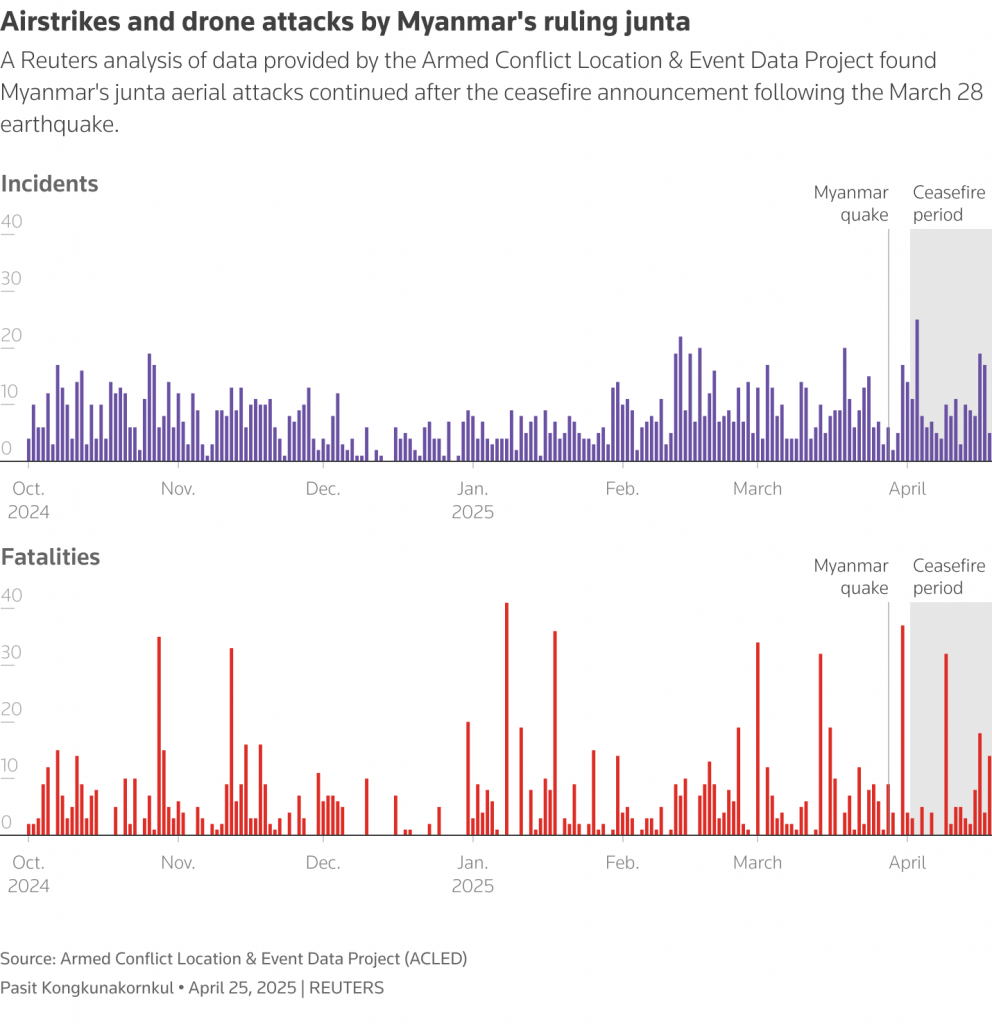Myanmar’s regime has kept up a deadly military campaign, including airstrikes and artillery assaults, despite announcing a ceasefire after a major earthquake killed thousands in March, according to the U.N. and data from a crisis monitor.
The March 28 quake, the worst natural disaster to hit the impoverished nation in decades, triggered a multi-national relief effort to support hundreds of thousands already ravaged by conflict and repeated international calls to halt the fighting.
On April 2, following similar moves by opposition armed groups, Myanmar’s military announced a 20-day ceasefire to support humanitarian relief. On Tuesday it said the temporary cessation had been extended until April 30 after rare high-level talks led by Malaysia’s premier.
But unreported figures from the U.N. show that the fighting has continued unabated and a Reuters analysis of data provided by the Armed Conflict Location & Event Data Project (ACLED) found the frequency of regime aerial attacks has increased since the ceasefire announcement, compared to the six months prior.
A regime spokesperson did not respond to multiple calls from Reuters seeking comment.
Between March 28 and April 24, the military launched at least 207 attacks, including 140 airstrikes and 24 artillery barrages, according to data from the U.N. Human Rights Office, based on reports it had received.
More than 172 attacks have occurred since the ceasefire, 73 of them in areas devastated by the earthquake.
“It’s business as usual,” said James Rodehaver, Myanmar head for the U.N. Office on Human Rights.
“The ceasefire…should have involved stopping all military activity and repurposing your military to support the humanitarian response and that has not happened.”
Myanmar has been in crisis since the military seized power in February 2021, toppling the elected government of Nobel Laureate Aung San Suu Kyi.
A brutal military crackdown on the opposition ignited a spiralling civil war, including in the previously peaceful central heartlands where protesters took up arms.

Civilian targets
Two weeks into the ceasefire, regime aircraft swooped over South Kan Ma Yaik village in southeastern Karen State on April 16, during Myanmar New Year celebrations, and dropped bombs that killed a pregnant woman and her unborn baby to the north of the settlement, an eyewitness told Reuters.
“The first bomb exploded near her house. Then she braced her children for a second bomb and shrapnel hit her body,” said the witness, who asked not to be named for fear of retribution.
“All the children were bleeding all over.”
Reuters could not independently verify the witnesses’ account but the ACLED data contains an entry for a regime attack on the village on April 16, including one fatality.
In the six months before April 2, the regime conducted an average of 7.6 attacks using aircraft or drones that killed more than five people daily, including civilians, according to data provided by ACLED.
Between April 2 and April 18, the military carried out an average of 9.7 aircraft or drone attacks every day, leaving more than six people dead each day, since the ceasefire was announced, ACLED data shows.
In all, 105 people were killed by regime aerial attacks during this period.
The data showed opposition groups only conducted three aerial attacks during the ceasefire, between April 2-18. Anti-regime groups in the country lack any conventional air force and rely on drones.
In contrast, the Myanmar Air Force includes Chinese and Russian-made fighter and ground attack aircraft, Russian attack helicopters and some heavy unmanned aerial vehicles, according to an International Institute for Strategic Studies (IISS) report last year.
The regime’s aerial attacks since the quake have been in the Sagaing Region and northern Shan State, where it is attempting to regain strategic positions, as well as in Kachin and Rakhine states, said ACLED Senior Analyst Su Mon.
“The military is still conducting aerial strikes that target civilian populations,” she said.
In its ceasefire announcements, on April 2 and April 22, the regime said that it would retaliate against a range of actions by resistance groups, including recruitment and territorial expansion.
In a few instances, the data indicated that the military was attacked by armed groups prior to launching an airstrike, the U.N.’s Rodehaver said.
Referring to the regime, he added: “Whenever you get attacked by… small arms fire, your response is to launch airstrikes on an area and you end up killing a dozen people who were not involved in the fighting at all. Is that a ceasefire?”
REUTERS



